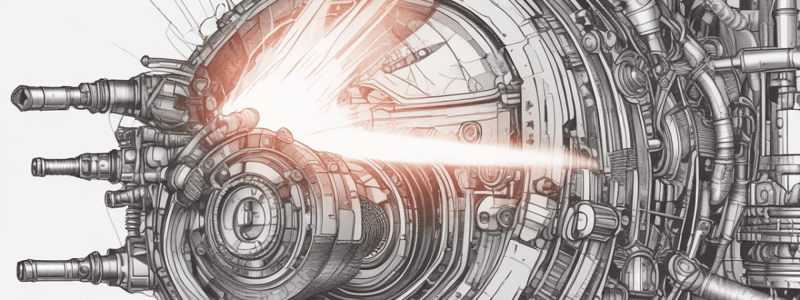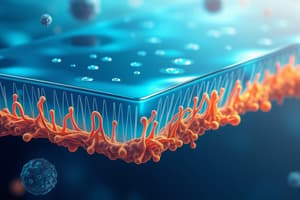Podcast
Questions and Answers
What is oxyfuel-gas welding?
What is oxyfuel-gas welding?
- A thermal cutting process
- A type of flame straightening process
- A type of arc welding process
- A group of welding processes that use the flame produced by the combustion of a fuel gas and oxygen as the source of heat (correct)
Oxyacetylene welding is a type of arc welding process.
Oxyacetylene welding is a type of arc welding process.
False (B)
What is the purpose of preheating the metal in oxyacetylene welding?
What is the purpose of preheating the metal in oxyacetylene welding?
To provide shielding from oxidation
The maximum temperature is at the _______________________.
The maximum temperature is at the _______________________.
Match the following welding processes with their descriptions:
Match the following welding processes with their descriptions:
What is the name of the device used to control the flame in oxyacetylene welding?
What is the name of the device used to control the flame in oxyacetylene welding?
Oxyfuel-gas welding is a type of thermal cutting process.
Oxyfuel-gas welding is a type of thermal cutting process.
What is the purpose of the oxyacetylene flame in welding?
What is the purpose of the oxyacetylene flame in welding?
What is the primary advantage of plasma arc welding?
What is the primary advantage of plasma arc welding?
Plasma arc cutting is a slower process compared to other thermal cutting methods.
Plasma arc cutting is a slower process compared to other thermal cutting methods.
What is the name of the gas flow that transfers heat to the workpiece and melts the metal in plasma arc torches?
What is the name of the gas flow that transfers heat to the workpiece and melts the metal in plasma arc torches?
What is the temperature of an oxidizing flame?
What is the temperature of an oxidizing flame?
Plasma arc cutting produces the highest temperatures available from any practical _______________.
Plasma arc cutting produces the highest temperatures available from any practical _______________.
Oxyhydrogen-gas welding can be used to weld ferrous metals.
Oxyhydrogen-gas welding can be used to weld ferrous metals.
What is the main difference between GTAW and plasma arc welding?
What is the main difference between GTAW and plasma arc welding?
Plasma arc welding can be used to weld all metals and alloys.
Plasma arc welding can be used to weld all metals and alloys.
Flame straightening uses controlled, localized _______________ as a means of straightening warped or buckled material.
Flame straightening uses controlled, localized _______________ as a means of straightening warped or buckled material.
What is the most common thermal cutting process?
What is the most common thermal cutting process?
What is the advantage of plasma arc welding in terms of distortion?
What is the advantage of plasma arc welding in terms of distortion?
Arc welding uses an oxyfuel-gas torch.
Arc welding uses an oxyfuel-gas torch.
What is the name of the process that uses an oxyfuel-gas torch to cut materials underwater?
What is the name of the process that uses an oxyfuel-gas torch to cut materials underwater?
Which of the following welding processes is best used for welding ferrous metals?
Which of the following welding processes is best used for welding ferrous metals?
Flux-Cored Arc Welding (FCAW) equipment costs less than SMAW.
Flux-Cored Arc Welding (FCAW) equipment costs less than SMAW.
What is the purpose of the flux in Shielded Metal Arc Welding (SMAW)?
What is the purpose of the flux in Shielded Metal Arc Welding (SMAW)?
In Gas Metal Arc Welding (GMAW), the supplemental shielding gas flows through the _______________________.
In Gas Metal Arc Welding (GMAW), the supplemental shielding gas flows through the _______________________.
Match the welding processes with their characteristics:
Match the welding processes with their characteristics:
Submerged Arc Welding (SAW) uses a shielding gas.
Submerged Arc Welding (SAW) uses a shielding gas.
What is the primary purpose of Stud Welding?
What is the primary purpose of Stud Welding?
Which welding process is best suited for making butt or fillet welds in low-carbon steels?
Which welding process is best suited for making butt or fillet welds in low-carbon steels?
What is the primary function of helium in Gas Tungsten Arc Welding (GTAW)?
What is the primary function of helium in Gas Tungsten Arc Welding (GTAW)?
GTAW welded materials are always thicker than ¼ in.
GTAW welded materials are always thicker than ¼ in.
What is the most widely used gas in Gas Tungsten Arc Welding (GTAW)?
What is the most widely used gas in Gas Tungsten Arc Welding (GTAW)?
In GTAW, the weld nugget begins to form at the surface where the _______________ makes contact.
In GTAW, the weld nugget begins to form at the surface where the _______________ makes contact.
Match the following components with their functions in GTAW:
Match the following components with their functions in GTAW:
What is the primary advantage of using helium in GTAW?
What is the primary advantage of using helium in GTAW?
Oxyfuel-gas welding is a type of arc welding process.
Oxyfuel-gas welding is a type of arc welding process.
What is the purpose of the vented nozzle on the modified TIG gun in GTAW?
What is the purpose of the vented nozzle on the modified TIG gun in GTAW?
Oxyacetylene welding uses a combination of oxygen and ______ gases to produce a high-temperature flame for welding and cutting metals.
Oxyacetylene welding uses a combination of oxygen and ______ gases to produce a high-temperature flame for welding and cutting metals.
The ______ contains valves for oxygen and acetylene flow control.
The ______ contains valves for oxygen and acetylene flow control.
The ______ is where oxygen and acetylene gases mix.
The ______ is where oxygen and acetylene gases mix.
A ______ flame is a balanced mixture of oxygen and acetylene; ideal for welding.
A ______ flame is a balanced mixture of oxygen and acetylene; ideal for welding.
To light the torch, open the ______ valve slightly.
To light the torch, open the ______ valve slightly.
Increasing oxygen flow increases ______ temperature and velocity.
Increasing oxygen flow increases ______ temperature and velocity.
Study Notes
Plasma Arc Torches
- Emerging gas transfers its heat to the workpiece and melts the metal, called the orifice gas flow.
- Characteristics of plasma arc welding: fast welding speed, narrow welds with deep penetration, narrow heat affected zone, reduced distortion, and can be used to weld all metals and alloys.
Arc Cutting
- Types of arc cutting: carbon arc and shielded metal arc cutting, air carbon arc cutting, oxygen arc cutting, gas metal arc cutting, and plasma arc cutting.
- Plasma arc cutting produces the highest temperatures available, is more economical, more versatile, and much faster.
Oxyfuel-Gas Welding Process
- Uses oxyfuel gas flame as the source of heat.
- Types of flames: neutral flame, oxidizing flame, and carburizing flame.
- Alternative fuel gases: propane, propylene, butane, natural gas, and hydrogen.
Oxyfuel-Gas Cutting
- Oxy-fuel gas cutting (flame cutting) is the most common thermal cutting process.
- Metal is melted by the flame of the oxyfuel gas torch.
Arc Welding
- Types of arc welding: shielded metal arc welding (SMAW), flux-cored arc welding (FCAW), gas metal arc welding (GMAW), and submerged arc welding (SAW).
- Shielded metal arc welding (SMAW):
- Most widely used process due to versatility and low-cost equipment.
- Best used for welding ferrous metals (carbon steels, alloy steels, stainless steels, and cast iron).
- Flux-cored arc welding (FCAW):
- Best used for welding steels.
- Equipment cost greater than SMAW.
- Needs good ventilation to remove fumes generated by the vaporizing flux.
- Gas metal arc welding (GMAW):
- Formerly known as metal inert-gas welding or MIG.
- Supplemental shielding gas flows through the torch.
- Consumable electrode: continuous, solid, uncoated wire or a continuous hollow tube with powdered alloy additions as consumable electrode.
- Submerged arc welding (SAW):
- Granular flux is deposited just ahead of bare-wire consumable electrode, and the arc is maintained beneath the blanket of flux.
- No shielding gas used.
- Most suitable for making butt or fillet welds in low-carbon steels.
Other Processes
- Stud welding: used to attach studs, screw, pins or other fasteners to a metal surface.
- Flame straightening: uses controlled, localized upsetting as a means of straightening warped or buckled material.
Oxyacetylene Welding Torch
Principle
- Oxyacetylene welding uses a combination of oxygen and acetylene gases to produce a high-temperature flame for welding and cutting metals.
Components
- Torch Handle: contains valves for oxygen and acetylene flow control
- Mixing Chamber: where oxygen and acetylene gases mix
- Nozzle: where the flame is produced
- Hoses: supply oxygen and acetylene gases to the torch
Operation
- Lighting the Torch: open oxygen valve slightly, light the torch with a spark or flame, and adjust oxygen flow to achieve a neutral flame (feather-edged, blue-colored)
- Adjusting the Flame:
- Increasing oxygen flow increases flame temperature and velocity
- Increasing acetylene flow increases flame size and reduces temperature
Types of Flames
- Neutral Flame: balanced mixture of oxygen and acetylene; ideal for welding
- Oxidizing Flame: excess oxygen; used for cutting and heavy welding
- Carburizing Flame: excess acetylene; used for bronze welding and brazing
Safety Precautions
- Wear protective gear (gloves, goggles, apron)
- Ensure good ventilation
- Keep the torch and hoses away from heat sources and sparks
Studying That Suits You
Use AI to generate personalized quizzes and flashcards to suit your learning preferences.
Related Documents
Description
This quiz covers the basics of Gas Flame and Arc Welding Processes




